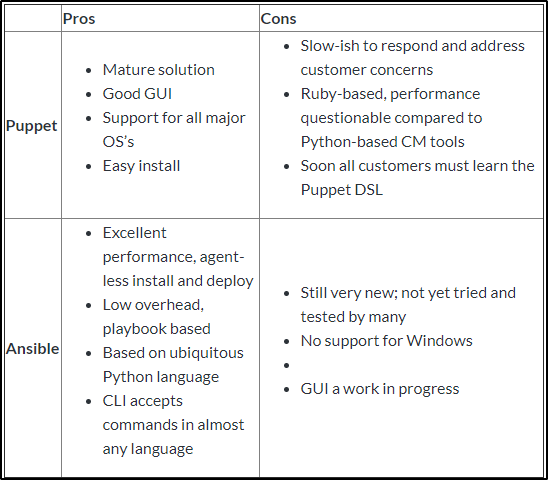Here are few major contrasts among Puppet and Ansible:
Puppet framework by and large contains (at least 1) "puppetmaster" servers, alongside a specialist package installed on every client node.
Ansible has neither an exceptional master server, nor specialist executables to install. The agent can be any machine with a list (inventory) of the nodes to contact, the Ansible playbooks, and the best possible SSH keys/certifications so as to interface with the nodes.
Puppet nodes have special client software and intermittently look into a puppet master server to "pull" resource definitions.
Ansible pursues a "push" work process. The machine where Ansible keeps running from SSH's into the client machines and uses SSH to duplicate records, remotely install bundles, and so on. The client machine VM requires no uncommon arrangement outside of a working installation of Python 2.5+.
Puppet: Resources characterized in a Puppet manifest are not connected arranged by their appearance (ex: top->bottom) which is mistaking for individuals who come from ordinary programming languages (C, Java, and so on). Rather resources are connected randomly, unless explicit resource ordering is used. Ex: “before”, ”require”, or chaining arrows.
Ansible: The playbooks are connected top-to-bottom, as they show up in the file. This is increasingly instinctive for developers coming from other different languages.
Puppet is built upon Ruby and the Ruby ecosystem of tools for testing . Adding complex functionality is done through Ruby modules.
Ansible is built upon Python for which most R&D orgs will have some experience.
Puppet has its own DSL which is a subset of Ruby. It’s not a Turing-complete language and was specifically designed to “be accessible to sysadmins“.
Ansible playbooks are YAML files.
Puppet templates are based upon Ruby’s ERB.
Ansible templates are based upon Jinja2, which is a superset of Django’s templating language.
The table below summarizes a few Pros and Cons of Ansible and Puppet so that you can differentiate between the two configuration management tools:

 REGISTER FOR FREE WEBINAR
X
REGISTER FOR FREE WEBINAR
X
 Thank you for registering
Join Edureka Meetup community for 100+ Free Webinars each month
JOIN MEETUP GROUP
Thank you for registering
Join Edureka Meetup community for 100+ Free Webinars each month
JOIN MEETUP GROUP